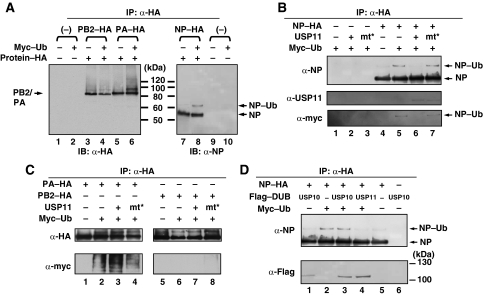Figure 5.
NP is a monoubiquitinated protein and can be deubiquitinated by USP11 in vivo. (A) 293T cells were mock transfected (lanes 1 and 9), or co-transfected with ubiquitin (Ub) and each plasmid encoding PB2–HA (lanes 3 and 4), PA–HA (lanes 5 and 6), or NP–HA (lanes 7 and 8), respectively. At 40 h after transfection, the cell lysates were subjected to immunoprecipitation (IP) assays with anti-HA antibody. Immunoprecipitated proteins were separated and then visualized by immunoblot with anti-HA antibody or anti-NP antibody, respectively. (B) 293T cells were co-transfected with plasmids that can express NP–HA, USP11, USP11–cys mutant and Myc–Ub as indicated. At 40 h after transfection, the cell lysates were prepared and subjected to immunoprecipitation (IP) assays with anti-HA antibody. Immunoprecipitated proteins were separated and then visualized by immunoblot with anti-NP, anti-USP11 and anti-myc antibody, respectively. (C) The protocol was as described in (B). The NP–HA plasmid was replaced by PA–HA or PB2–HA, and visualized by immunoblot with anti-HA and anti-myc antibodies. (D) 293T cells were co-transfected with plasmids that can express NP–HA, Flag–USP10, Flag–USP11 and Myc–Ub as indicated. At 40 h after transfection, the cell lysates were prepared and subjected to immunoprecipitation (IP) assays with anti-HA antibody. Immunoprecipitated proteins were separated and then visualized by immunoblot with anti-NP and anti-Flag antibody respectively.

